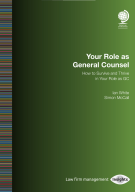
Why is renewable energy particularly timely right now?
It is becoming increasingly obvious to all but the most hardened climate sceptics that the world needs to transition to a low carbon economy. The reasons for this are numerous and well documented. An increase in global warming beyond two degrees centigrade caused by the release of greenhouse gases would be dangerous for human populations and threaten many of the planet's natural systems. Energy security of supply is critical, as is reducing exposure to a potentially volatile fossil fuel price.
The development of renewable energy generation will create ‘green jobs’ and represents, particularly for the United Kingdom, a real opportunity to rebuild an ageing grid infrastructure in a carbon-efficient manner. Finally, both governments and corporates are keen to be seen to embrace social responsibility and adapt their behaviour to demonstrate their green credentials and ‘greenify’ their supply chains.
What are the main considerations when financing a renewable energy project?
A financier will look at a renewable energy project and assess how best to deal with certain risks. Taking a wind farm as an example, at its most basic level, will the wind blow sufficiently to enable effective power generation? Will the relevant permits, such as generation licences or planning permissions, be in place? How often will the turbines need to be maintained? What guarantees are there that the project will be constructed and completed on time? Who will buy the electricity produced?
In addition to these practical considerations, perhaps the most important issue in the renewables industry is whether a sufficiently robust subsidy regime is in place to guarantee a long-term revenue. The withdrawal of a subsidy is likely to have a negative effect on either the continued existence of a project or the cash-flow generating capacity of a project. We have seen this particularly in the context of feed-in tariffs being reduced in certain European countries such as Spain and Germany.
What is the UK coalition government's position on renewables?
The United Kingdom has enacted binding emissions reduction targets under the Climate Change Act 2008 to reduce its greenhouse gas emissions by 34% by 2020 and by 80% by 2050, in each case based on 1990 levels. The United Kingdom is also required to generate 15% of energy from renewable sources by 2020.
The UK coalition government has pledged to be the "greenest Government ever" and has been broadly supportive of renewable energy. The Comprehensive Spending Review announced in October 2010 did not have as severe an effect on renewables subsidy regimes as had been feared. The feed-in tariff for small-scale renewables projects introduced by the previous government has been maintained, as has the concept of the Carbon Reduction Commitment Energy Efficiency Scheme - albeit in the latter case with some controversial amendments to veto the proposed recycling of payments to high-performing participants.
Late last year, the Department of Energy and Climate Change and the Treasury issued consultations on a carbon price support mechanism, the introduction of a feed-in tariff subsidy system that would eventually replace the current renewables obligation system, further support for carbon capture and storage and an energy performance standard, as well as confirming its support for a renewable heat incentive scheme. It will be interesting to follow the government's position on nuclear over the coming months, given the Liberal Democrats' traditional reluctance to embrace this policy.
Which sector of the renewables industry do you think is the most promising?
There is a lot of talk about the more innovative sectors of the renewables industry, such as carbon capture and storage, wave and tidal, geothermal, electric vehicles and micro-algae. However, these sectors have failed to attract a significant amount of investment due to concerns about their viability.
For our part, a very promising area into which a significant amount of investment is being made is the energy efficiency sector, particularly in relation to energy management and the introduction of so-called ‘smart grids’, and we would see this trend as continuing. This is perhaps unsurprising during these times of austerity, given that most technologies that make energy consumption more efficient will also result in cheaper energy bills.
What are the prospects for renewable energy around the world?
It is obvious that the action of one or more governments is not enough to tackle the global challenge of climate change. A coordinated response is required. However, one of the biggest challenges facing climate change action on a global scale is the differing characteristics of the nations involved.
The European Union continues to tackle climate change through its European and individual member state targets and through mechanisms such as the EU Emissions Trading Scheme. Elsewhere in the world, China and India are becoming increasingly important players in the climate debate, with the former recently being named by Ernst & Young as the most attractive country to invest in renewable energy.
Despite their plentiful supplies of fossil fuels, all of the Middle East states are focusing on renewable energy, not least Abu Dhabi through its Masdar initiative. Disappointingly, President Obama has been unable to push through climate change legislation in the United States, a situation which seems unlikely to change given the strength of the Republican Party in both Congress and the Senate.
The biggest barrier to further development of renewable energy around the world is probably the fear of developing nations that climate change action could stifle their economic development. The developed economy therefore needs to engage with developing nations to ensure that the latter can continue with their economic development and growth within a low carbon framework - for example, using technologies such as carbon capture and storage.







